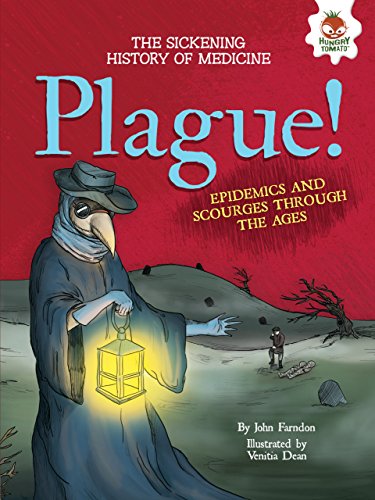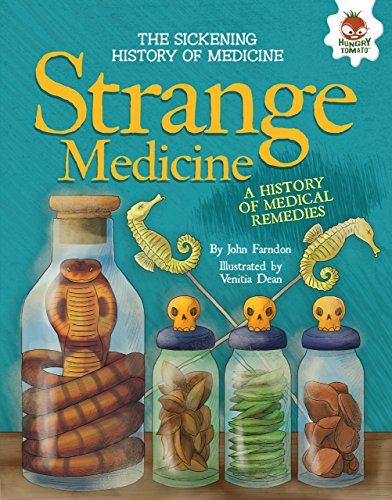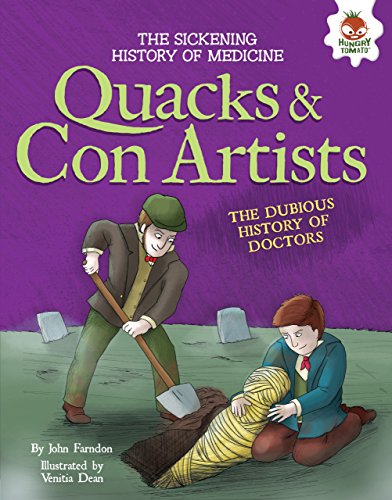-
Plague!: Epidemics and Scourges Through the Ages
John Farndon, Venitia Dean
Paperback (Hungry Tomato ®, Jan. 1, 2017)Being sick is horrible. But it used to be worse. Inside this book, you'll see evidence of the plagues of the past―rotting skin, dissolving lungs, and sinister swelling all over the body. Diseases like the Black Death wiped out whole towns and villages. Tuberculosis consumed young people like a bloodsucking vampire. And Smallpox left its victims scarred for life―if they survived. At the time, no one knew where these killer diseases came from or how to treat them. But eventually doctors discovered how these diseases and others were spread. Being sick isn't quite as sickening as it was in the past! Z
Z
-
Tiny Killers: When Bacteria and Viruses Attack
John Farndon, Venitia Dean
Paperback (Hungry Tomato ®, Jan. 1, 2017)Invisible microbes cause sickness by invading our bodies and multiplying. But doctors didn't always know that sickness was caused by germs. Most people thought diseases came from smelly, damp air. But over time, those ideas changed. A Dutch scientist saw bacteria through his microscope. Doctors realized that when they washed their hands, fewer people died. And a doctor in London recognized that disease could spread through contaminated water. Because of these discoveries, people eventually learned that hygiene was the key to stopping disease. Hospitals used clean surgical instruments, and cities developed trash removal and sewage systems. Learn more about the discovery and defeat of bacteria! X
X
-
Strange Medicine: A History of Medical Remedies
John Farndon, Venitia Dean
Paperback (Hungry Tomato ®, Jan. 1, 2017)It's easy to take a pill when we aren't feeling well. But did you know that the art of making medicines goes back thousands of years? Early remedies weren't always so easy―or effective. Some seemed downright disgusting. Wine infused with a venomous snake was used to cure fatigue and hair loss. Snail slime soothed burns, and a mixture of ear wax and mud treated headaches. Discover more about how medicine was practiced centuries ago and how, eventually, scientists discovered some truly amazing remedies, from the magic bullet that treated syphilis to the insulin used for diabetes. X
X
-
Plague!: Epidemics and Scourges Through the Ages
John Farndon, Venitia Dean
Library Binding (Hungry Tomato ®, Jan. 1, 2017)Being sick is horrible. But it used to be worse. Inside this book, you'll see evidence of the plagues of the past―rotting skin, dissolving lungs, and sinister swelling all over the body. Diseases like the Black Death wiped out whole towns and villages. Tuberculosis consumed young people like a bloodsucking vampire. And Smallpox left its victims scarred for life―if they survived. At the time, no one knew where these killer diseases came from or how to treat them. But eventually doctors discovered how these diseases and others were spread. Being sick isn't quite as sickening as it was in the past! Z
Z
-
Quacks and Con Artists: The Dubious History of Doctors
John Farndon, Venitia Dean
Paperback (Hungry Tomato ®, Jan. 1, 2017)People have always needed doctors. But the doctors of the past might not look like the doctors you are used to seeing! Sometimes their healing methods were weird, disgusting, or even dangerous. Doctors in the Middle Ages sniffed patients' urine to diagnose disease, and barbers might cut off a person's injured arm or leg. The ancient Chinese fought smallpox by blowing powdered pus up the nose. Many of these old remedies turned out to be dangerous, but others paved the way for modern blood transfusions, vaccines, and anesthetics. If you're not too squeamish, read this book to learn more about the history of doctors! X
X
-
Prehistoric and Egyptian Medicine
Ian Dawson
Hardcover (Enchanted Lion Books, May 15, 2005)Travel through time, back before written language existed, to discover how early people understood the body. V
V
-
Strange Medicine: A History of Medical Remedies
John Farndon, Venitia Dean
Library Binding (Hungry Tomato ®, Jan. 1, 2017)It's easy to take a pill when we aren't feeling well. But did you know that the art of making medicines goes back thousands of years? Early remedies weren't always so easy―or effective. Some seemed downright disgusting. Wine infused with a venomous snake was used to cure fatigue and hair loss. Snail slime soothed burns, and a mixture of ear wax and mud treated headaches. Discover more about how medicine was practiced centuries ago and how, eventually, scientists discovered some truly amazing remedies, from the magic bullet that treated syphilis to the insulin used for diabetes. X
X
-
Quacks and Con Artists: The Dubious History of Doctors
John Farndon, Venitia Dean
Library Binding (Hungry Tomato ®, Jan. 1, 2017)People have always needed doctors. But the doctors of the past might not look like the doctors you are used to seeing! Sometimes their healing methods were weird, disgusting, or even dangerous. Doctors in the Middle Ages sniffed patients' urine to diagnose disease, and barbers might cut off a person's injured arm or leg. The ancient Chinese fought smallpox by blowing powdered pus up the nose. Many of these old remedies turned out to be dangerous, but others paved the way for modern blood transfusions, vaccines, and anesthetics. If you're not too squeamish, read this book to learn more about the history of doctors! X
X
-
Medicine in the Middle Ages
Ian Dawson
Hardcover (Enchanted Lion Books, May 15, 2005)This great interdisciplinary title goes far beyond medicine, revealing much about society at large.
-
Tiny Killers: When Bacteria and Viruses Attack
John Farndon, Venitia Dean
Library Binding (Hungry Tomato ®, Jan. 1, 2017)Invisible microbes cause sickness by invading our bodies and multiplying. But doctors didn't always know that sickness was caused by germs. Most people thought diseases came from smelly, damp air. But over time, those ideas changed. A Dutch scientist saw bacteria through his microscope. Doctors realized that when they washed their hands, fewer people died. And a doctor in London recognized that disease could spread through contaminated water. Because of these discoveries, people eventually learned that hygiene was the key to stopping disease. Hospitals used clean surgical instruments, and cities developed trash removal and sewage systems. Learn more about the discovery and defeat of bacteria! X
X
-
Early Civilizations: Prehistoric Times to 500 C.E.
Kate Kelly
Hardcover (Ferguson Publishing Company, Aug. 1, 2009)The story of early medicine is one of magic and sorcery, religion and prayers, shamans and surgeons, and ingenuity and experimentation. This title includes chapters such as: Paleopathology - the Study of Disease in Prehistoric Times; What the Mummies Reveal; Indian Influence on Medicine; and, Medical Progress During the Roman Empire.
-
Medicine in the Middle Ages
Ian Dawson
Hardcover (Hodder Childrens Book, May 16, 2005)None